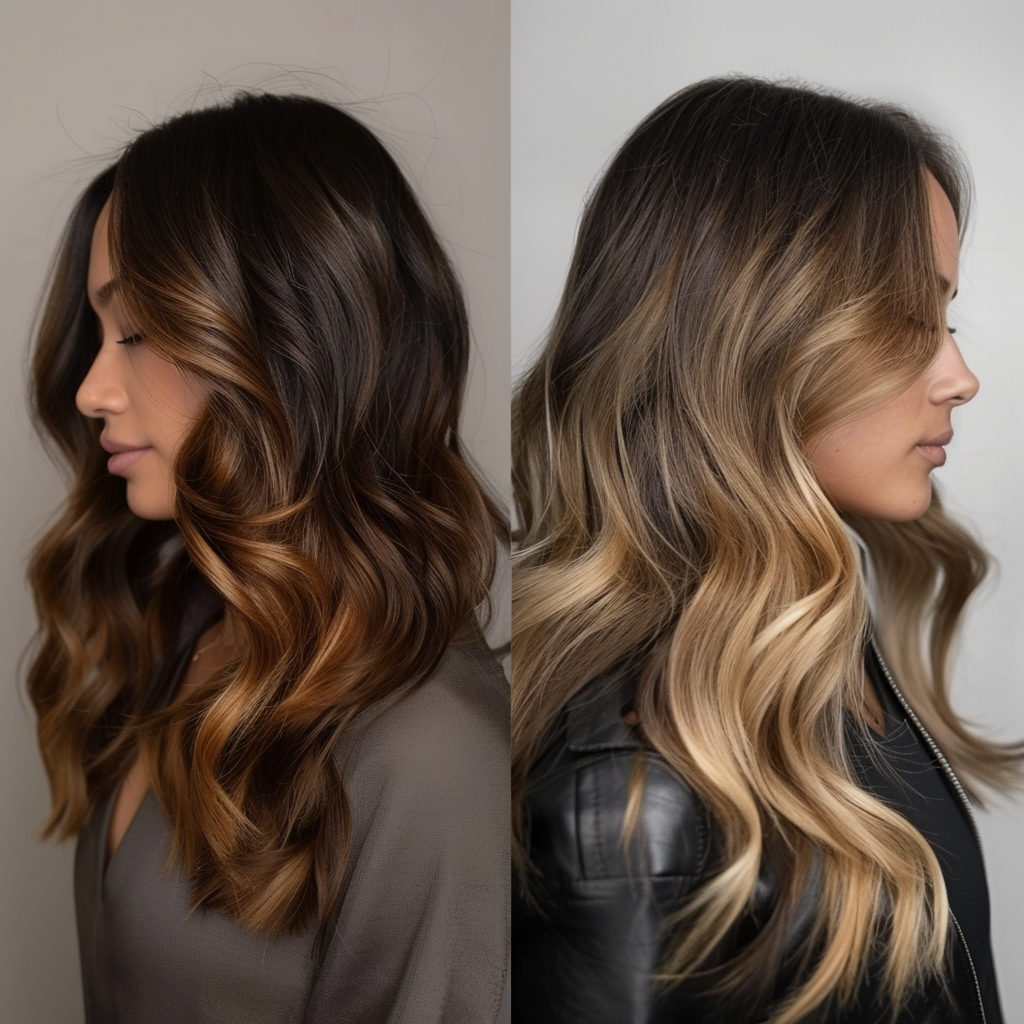Dimensional Balayage Vs. Traditional Highlights: Which Is Right for You?
Choosing between dimensional balayage and traditional highlights hinges on your aesthetic goals and maintenance capacity. Balayage employs a freehand technique for a sun-kissed, blended effect, perfect for a natural, low-maintenance look with warmer tones. It’s highly customizable but may require multiple sessions for best results on darker hair. In contrast, traditional highlights utilize precise sectioning with foils, ensuring uniform color and brightness ideal for a polished and structured appearance. This method is effective for adding contrast and covering greys but demands more frequent salon visits. For more in-depth insights, further exploration is invaluable.
Balayage Technique
The balayage technique, characterized by its freehand application of color without the use of foils, creates a naturally sun-kissed and seamlessly blended look that is highly customizable to each individual’s preferences. This freehand painting technique allows for an artistic approach, achieving softer and more blended color shifts. The outcome often leans towards warmer tones, enhancing the hair’s natural depth and dimension. The customizable nature of balayage guarantees that each application can be tailored to fit personal style and hair type. This method results in a more natural appearance, with lighter pieces gradually blended from the roots to the ends. The artistic freedom inherent in balayage makes it a preferred choice for those seeking a unique, effortlessly chic look.
Benefits of Balayage
Offering a myriad of advantages, balayage stands out for its ability to create a natural, sun-kissed look with soft, blended color shifts. This technique is renowned for delivering subtle highlights that seamlessly blend with the hair’s natural color, requiring less maintenance compared to traditional methods. The customizable nature of balayage allows for personalized color placement, making it adaptable to individual preferences and enhancing facial features. This versatility guarantees that each application is unique, tailored to complement the client’s specific hair texture, color, and skin tone. Additionally, the gradual shift from darker roots to lighter ends means fewer touch-ups, providing a low-maintenance yet sophisticated solution for those seeking a modern, effortless aesthetic.
Drawbacks of Balayage
While balayage boasts numerous benefits, it also comes with several drawbacks that potential candidates should consider. For those with darker hair, achieving the desired balayage effect can be particularly challenging, often necessitating multiple sessions to reach the ideal hue, which increases both time and cost. Balayage may not offer as much control over color placement and intensity compared to traditional highlighting techniques, making it less suitable for those desiring a more structured or defined look. Additionally, maintenance can be tricky, especially for individuals with fine or thin hair, as the color tends to fade more quickly. Therefore, while balayage provides a natural, sun-kissed appearance, its suitability varies depending on hair type and desired outcome.
Traditional Highlighting Process
In contrast to the freer, more artistic approach of balayage, traditional highlighting employs precise sectioning and foil techniques to achieve a consistent, controlled lightening effect from roots to ends. This traditional technique involves weaving sections of hair and isolating them in foils to guarantee a uniform color lift. Specific sectioning techniques are meticulously applied to avoid streaks and maintain even coverage.
- Woven sections of hair: Strands are carefully selected to create a balanced contrast.
- Foils: Essential for isolating hair sections and controlling the lightening process.
- Uniform color lift: Ensures consistent lightening across all highlighted areas.
This method is ideal for those seeking a structured, defined look with precise color placement.
Benefits of Highlights
Highlights provide a structured and customizable approach to adding brightness and dimension to your hair, making them ideal for those seeking a bold and noticeable transformation. Traditional highlights, often achieved using foil techniques, offer a controlled application that guarantees precise placement of lighter streaks, enhancing contrast and creating a striking visual impact. This method is particularly effective for covering grey hair and can be tailored to achieve various levels of intensity and uniformity. The defined sections of lighter color allow for a more polished and sophisticated look, ideal for those desiring a standout change. Additionally, the versatility of foil highlights ensures they can be adapted to numerous hair types and styles, maintaining a trend-aware appearance.
Drawbacks of Highlights
Maintaining traditional highlights can be challenging due to the frequent salon visits required to address regrowth and preserve color vibrancy. This high-maintenance approach can be time-consuming and costly, often requiring touch-ups every 4-6 weeks. Highlights can also result in visible regrowth lines, which detract from a polished appearance and necessitate prompt attention. Additionally, the lightening process involved in creating highlights can cause potential damage to the hair, especially with repeated treatments.
- Frequent salon visits: Regular touch-ups to maintain color and manage regrowth.
- Visible regrowth lines: Obvious contrast between natural hair color and highlighted sections.
- Potential damage: Repeated lightening can weaken hair integrity, leading to breakage and dryness.
These factors make traditional highlights a high-maintenance choice.
Choosing Between Balayage and Highlights
Deciding between balayage and traditional highlights hinges on understanding the distinct techniques and desired aesthetic outcomes each method offers. When considering balayage vs highlights, recognize that balayage provides a natural, sun-kissed effect through hand-painted strokes, ideal for a low-maintenance routine. Conversely, traditional highlights utilize foils for precise color placement, resulting in a more structured and high-contrast appearance. Evaluate your hair tone and maintenance needs: balayage suits various tones with minimal upkeep, while highlights may necessitate frequent touch-ups. Consulting with a stylist can provide personalized insights based on your hair type and lifestyle. Understanding these differences in technique and maintenance will guide you in achieving your desired outcome, ensuring a harmonious fit with your personal style.
Conclusion
To sum up, deciding between dimensional balayage and traditional highlights is like choosing between a watercolor painting and a precision blueprint. Each technique offers unique advantages and potential drawbacks, tailored to specific aesthetic preferences and hair characteristics. Understanding these distinctions enables an informed decision, aligning individual taste with the desired outcome. As hair color trends continually evolve, mastering the nuances of these methods guarantees a harmonious and sophisticated transformation.
